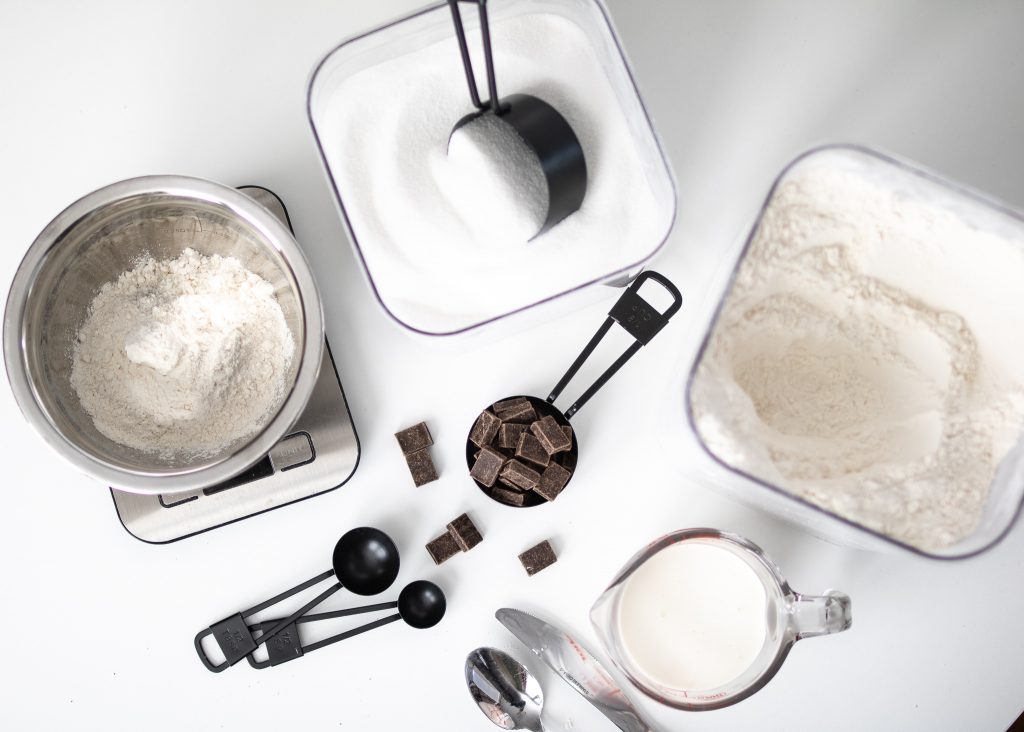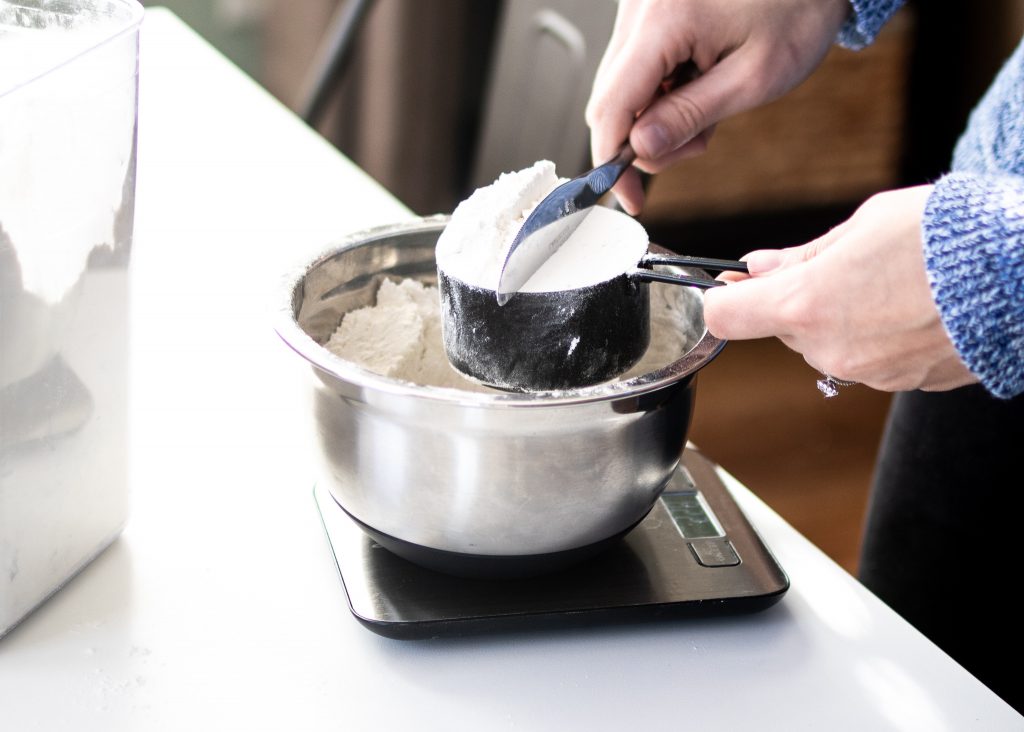How to Properly Measure
Measuring correctly has a huge impact on the result of what you’re baking. You can go from soft cookies to overly dry cookies by just a tablespoon extra flour! Learn how to measure basic ingredients correctly to help achieve the best bakes possible!

Dry Ingredients
FLOUR: The ingredient most commonly mis-measured! Flour is so easy to “pack” – meaning the flour packs down when you scoop your measuring cup in the bowl and you can end up with sometimes 50% more! Because of that, this ingredient is best measured with a SCALE. You’ll end up with the precise amount every time. It also can make baking faster! Especially recipes like “5 cups”. So much easier to dump into a bowl and watch the number than to carefully measure out each cup. You can get a basic inexpensive scale on Amazon, like this one. If you don’t have a scale, the next best way to measure is through the “spoon and level” method. This is done by loosely spooning flour into your measuring cup, then leveling it off with the back of a knife or leveler. You still may get slightly more flour in your cup compared to using a scale, but it’s significantly closer to accuracy than scooping and packing. These principles apply to cocoa powder as well!
WHITE SUGAR: For those extremely precise recipes like macarons or souffles, scales are best. But, in most basic recipes like muffins or brownies, you can get away with just scooping the cup into your bag of sugar. Because sugar is hard and fine, it doesn’t pack the way flour does. Spooning and leveling vs just scooping will actually yield the exact same amount in my experience. So save yourself the time and feel free to scoop away with this one! Still LEVEL OFF though! The “shake at the end” method, often still yields up to a couple tablespoons more! Yikes!
BROWN SUGAR: Unless a recipe says otherwise, always pack brown sugar into a measuring cup. I like to do this by using the back of a spoon and then making sure its packed level at the top.
POWDERED SUGAR: Recipes are commonly written two different ways in regards to IF and WHEN you sift the powdered sugar. If it doesn’t indicate any sifting, use a scale or spoon and level. Otherwise, here’s a tip on how to read the recipe:
- 1 cup confectioner’s sugar, sifted = spoon and level (or weigh) one cup THEN sift
- 1 cup sifted confectioner’s sugar = sift THEN weigh or spoon and level what’s been sifted
SALT, BAKING SODA, YEAST, SPICES, ETC: Shake around the can a bit to loosen things up evenly, then you can scoop using the measuring spoon and level off.
ADDERS – CHOCOLATE CHIPS, NUTS, ETC. : In most cases adders are typically safe and easy. A few chocolate chips off never hurt a cookie! However, it is important to be aware of how you are using these adder ingredients. There are disagreeing amounts on how much chocolate chips weigh for example. This weight isn’t always crucial, but just be aware that the varying size of your ingredients (due to brand or otherwise) may impact the intention of the recipe. For example, 1 cup of chocolate chips weighs differently than 1 cup of M&M’s. So follow the recipe, but when it doesn’t say, use your best judgement!
In summary, a good quality scale is best for these varying dry ingredients and will never let you down. It also can be SO much faster and easier than making sure you measure precisely. You’ll find a list of measurements when using a scale down below on this page.
Wet Ingredients
The proper way to measure wet ingredients (water, milk, etc.) is always by looking at the measurement at eye level. Using a liquid measuring cup is the easiest and most accurate way to measure your ingredients. Plus it’s cleaner – water doesn’t spill over the measuring cup, etc.
Sticky Ingredients
I like to measure ingredients like peanut butter, honey, sour cream, etc. in a normal dry measuring cup.
Tip for these sticky ingredients! Spray your measuring cup with nonstick spray prior to pouring the ingredient in OR using plastic wrap to line the measuring cup for an easy and less messy release. If your recipe has both helpful elements, like bread recipes that may have oil and honey – put oil in first, then the honey – the honey slides right out! Otherwise, use a spatula to ensure all the yummy goodness gets into your recipe and not left in the cup!

Ingredient Weights
Here’s a list of the top ingredients I use regularly and weights I follow.
You can find a full comprehensive list of ingredients from King Arthur Flour here. A great resource to bookmark!! Cooks Illustrated also has a small list of basic ingredients with slightly different weights for comparison. Different brands can sometimes have slightly different standard of an ingredient’s weight.
- 1 cup all purpose flour: 125g
- 1 cup bread flour: 125g
- 1 cup whole wheat flour: 112g
- 1 cup Kamut flour: 112g
- 1/2 cup cocoa powder: 42g
- 1 cup rolled oats: 95g
- 1 cup granulated sugar: 200g
- 1 cup packed brown sugar: 200g
- 1 cup powdered sugar: 115g
- 1/4 cup cornstarch: 28g
